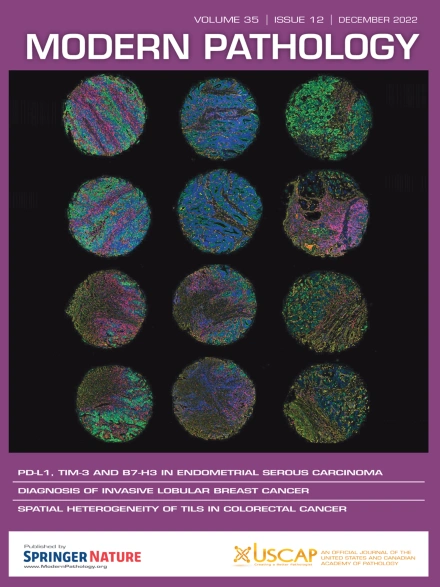Malignant Chondroblastoma: An Epigenetically Distinct Subtype of Chondroblastoma With a Predilection for the Skeletally Mature
IF 5.5
1区 医学
Q1 PATHOLOGY
引用次数: 0
Abstract
Malignant chondroblastoma is a recently described variant of chondroblastoma showing a distinct age/site distribution and morphology along with the typical H3-3B p.K36M mutation. We sought to further compare conventional and malignant chondroblastoma. Malignant chondroblastomas were collected. H3-3 K36M immunohistochemistry, as well as DNA methylation and copy number profiling, were performed and compared with conventional chondroblastoma. Forty-one samples from 26 patients were identified (20 males, 6 females; age: 19-62 years; median: 39 years). Anatomical sites included rib (7), pelvis (4), acromion (4), scapula (4), spine (2), long bone (3), calcaneus (1), and talus (1). Imaging showed an expansile mass with variable cortical erosion and/or breakthrough. Most patients (n = 17) showed sheets of atypical ovoid cells deposited in a myxoid stroma. Osteoclast-like giant cells/matrix formation was scarce. Six patients had tumors with features of conventional chondroblastoma but significant cytologic atypia. Three tumors demonstrated a morphology indistinguishable from conventional chondroblastoma except for extensive permeation, and one of these cases showed a transition to high-grade sarcoma. The final case was composed only of high-grade pleomorphic sarcoma that harbored an H3F3A p.K36M mutation. When an adjacent host bone was present, permeative growth through the cortex and native trabeculae was noted. All samples tested positive for the H3-3 K36M-specific antibody (26 of 26). Methylome profiling of 28 specimens from 24 patients revealed that 26 of these specimens formed a distinct cluster on a uniform manifold approximation and projection dimension reduction plot separate from conventional chondroblastoma and high-grade osteosarcoma. Of 26 methylomes from which interpretable copy number profiles can be derived, 12 had no variations, whereas 14 had copy number changes. Of 22 patients, 11 experienced local recurrence, 8 patients developed metastasis, and 3 patients died of disease. Malignant chondroblastoma is a rare, clinically and epigentically distinct variant of chondroblastoma with a predilection for the flat bones of skeletally mature individuals and high rates of local recurrence and distant metastases. A subset transforms into high-grade pleomorphic sarcoma, either de novo or in subsequent recurrences. Malignant chondroblastoma with high-grade features and/or copy number variations appears to have a higher propensity for adverse events, including death from disease.
恶性成软骨细胞瘤:一种表观遗传上不同的成软骨细胞瘤亚型,对骨骼成熟者有偏爱。
背景:恶性成软骨细胞瘤是最近发现的一种成软骨细胞瘤变体,具有明显的年龄/部位分布和形态,并伴有典型的H3-3B p.K36M突变。我们试图进一步比较常规和恶性软骨母细胞瘤。设计:收集恶性成软骨细胞瘤。我们进行了H3-3 K36M免疫组织化学、DNA甲基化和拷贝数分析,并与常规的成软骨细胞瘤进行了比较。结果:共检出26例患者41份样本(男20例,女6例;19岁至62岁;中位年龄39岁)。解剖部位包括肋骨(7个)、骨盆(4个)、肩峰(4个)、肩胛骨(4个)、脊柱(2个)、长骨(3个)、跟骨(1个)和距骨(1个)。影像学显示一个可扩张的肿块,伴有不同程度的皮质侵蚀和/或突破。大多数患者(n=17)表现为黏液样间质中沉积的非典型卵形细胞片。破骨细胞样巨细胞/基质形成较少。6例患者肿瘤具有常规成软骨细胞瘤的特征,但有明显的细胞学异型性。3例肿瘤表现出除了广泛浸润外与常规成软骨细胞瘤难以区分的形态,其中1例向高级别肉瘤转变。最后一例仅由含有H3F3A p.K36M突变的高级别多形性肉瘤组成。当相邻宿主骨存在时,可观察到通过皮质和原生小梁的渗透性生长。所有样本均检测出H3-3 K36M特异性抗体阳性(26个样本中有26个)。来自24例患者的28个标本的甲基组分析显示,其中26个标本在UMAP降维图上形成了一个独特的簇,与传统的成软骨细胞瘤和高级别骨肉瘤分开。在26个可解释拷贝数谱的甲基组中,12个没有变化,14个拷贝数有变化。22例患者中,11例局部复发,8例发生转移,3例死亡。结论:恶性成软骨细胞瘤是一种罕见的临床和表观遗传上独特的成软骨细胞瘤变异,易发生于骨骼成熟个体的扁平骨,局部复发和远处转移率高。一个子集转化为高级别多形性肉瘤,无论是新生的还是随后的复发。具有高级别特征和/或拷贝数变异的恶性成软骨细胞瘤似乎有更高的不良事件倾向,包括疾病死亡。
本文章由计算机程序翻译,如有差异,请以英文原文为准。
求助全文
约1分钟内获得全文
求助全文
来源期刊

Modern Pathology
医学-病理学
CiteScore
14.30
自引率
2.70%
发文量
174
审稿时长
18 days
期刊介绍:
Modern Pathology, an international journal under the ownership of The United States & Canadian Academy of Pathology (USCAP), serves as an authoritative platform for publishing top-tier clinical and translational research studies in pathology.
Original manuscripts are the primary focus of Modern Pathology, complemented by impactful editorials, reviews, and practice guidelines covering all facets of precision diagnostics in human pathology. The journal's scope includes advancements in molecular diagnostics and genomic classifications of diseases, breakthroughs in immune-oncology, computational science, applied bioinformatics, and digital pathology.
 求助内容:
求助内容: 应助结果提醒方式:
应助结果提醒方式:


